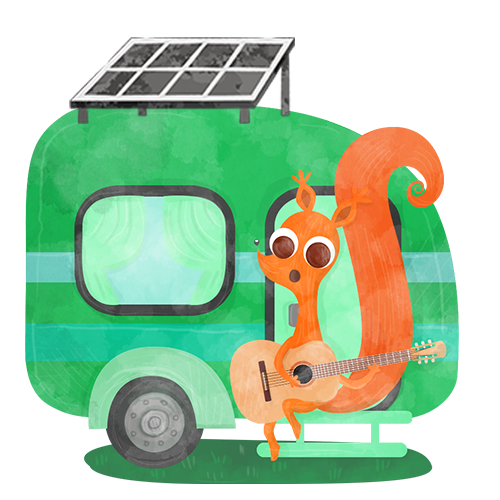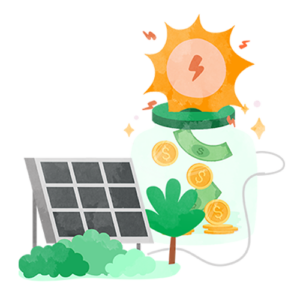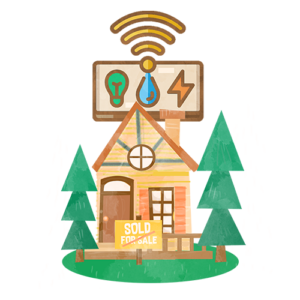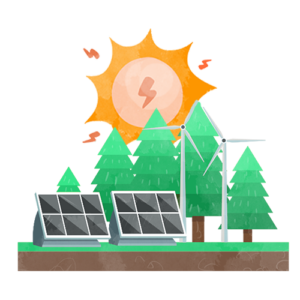
There’s nothing like a looming global financial catastrophe to make a person consider offloading all their possessions and moving to a cabin in the woods.
There’s plenty about living off the grid that seems appealing: developing a deeper connection with nature, the feeling of being completely self-sufficient, not having to constantly check three different email accounts — and that’s without getting into the woes of social media.
But is this a dream that’s actually achievable?

Exactly what one means when they talk about off the grid living changes from person to person. The most extreme examples involve disappearing from society and becoming a feral mountain dweller who obeys no laws but those of nature.
Folks on the other end of the spectrum just want to live in a van with little to no financial obligations to restrict their freedom to move about the world as they please.
Unfortunately, living completely and literally off the grid is not feasible for most people. While you might be capable of building a cabin in the woods and sustaining yourself there, in order to do so legally you’re going to need to own a piece of land — that means paying taxes, which sort of goes against the spirit of off the grid living.
So, for the purposes of this article, we’ll focus on a more practical version of off the grid living. It’s perfectly possible to meet all of the following requirements legally in the United States:
If your goal is to break free from your cubicle, or never have to set foot in a fluorescently-lit grocery store ever again, you could make that happen.

There are several benefits to off the grid living that make it an appealing lifestyle.
Lower carbon footprint
Contemporary society is not good for the environment. Going off grid, however, mitigates many of the most harmful aspects of living in the modern world.
When living off the grid, you use renewable energy sources as opposed to public utilities, reduce your overall consumption (since you won’t be ordering anything from Amazon anymore), and grow your own food rather than supporting industrial agriculture.
All of this shrinks your carbon footprint immensely.
Lower cost of living
Living off the grid means removing yourself from the global economy as much as possible, and that means spending a heck-of-a-lot less money. Groceries, subscriptions (like Netflix or Spotify), rent or mortgage payments, credit card debt, all go away when you move off grid.
In the ideal off the grid living scenario, the only actual expenses you have would be your property tax bill and the occasional purchase of a tool or service you can’t provide for yourself.
Improved mental health
You don’t need Jim Henson’s imaginative prowess to understand how living off the grid could result in improved mental health, but we’ll list a few of the big reasons just in case:
Reduced societal pressure — forget the stress of managing weekend plans across three overlapping friend groups: imagine never having to respond to a work email ever again.
Stronger connection with nature — there is a plethora of evidence that suggests being in nature makes you calmer, happier, and more creative, as well as reducing depression and anxiety.
More Freedom — there are a thousand tiny (and not so tiny) obligations that go along with participating in a modern society. Everything from having to wear clothing to the legal responsibility of home ownership adds up quickly to a fairly sizable ball and chain that restricts your ability to move freely about the world.
Clear Purpose — lots of people with white collar office jobs struggle to find meaning in their daily work. Living off the grid requires that you work to sustain yourself, and sustaining yourself is a fairly clear reason for working.

If living off the grid is starting to sound appealing to you, hold your horses for just another minute. Not just anyone can walk out of their office in downtown New York and go live in a cabin they built in the woods.
There are a few things you’re going to need to have set up in order for off the grid living to be feasible for you:
Skills
Living off the grid means you need to do basically everything for yourself. The most significant demand skill-wise is the ability to maintain your shelter and ensure you have a consistent supply of food and water (without going to Home Depot or the grocery store).
While you don’t necessarily need to build your house from scratch, you will need to repair it yourself if anything breaks (and it will).
So, basic plumbing, carpentry, and electrical knowledge are a must-have if you want to ensure that you always have a comfortable place to live and sleep where the bears and the water can’t get in.
You also need to be able to procure food for yourself. Whether this comes exclusively from gardening and farming or if you add some fishing and hunting into the mix is up to you.
Land
Where you choose to set up your home for off the grid living is going to depend a lot on exactly how off the grid you want to live.
Are you hoping for minimal human contact, or are you thinking you’ll want to be able to pop into town every now and then for supplies?
Beyond proximity to civilization, there are a few important considerations to make when scouting property:
Water source
Wherever you choose to live, you’re going to need access to running water, and there are several methods you could use to procure it.
A natural spring on-site is the ideal scenario, as it requires the least amount of setup, though finding property with a consistent, uncontaminated natural spring may be difficult (or expensive).
Digging a well is the most common method for folks living off the grid to obtain water. According to the Groundwater Foundation, over 42 million Americans supply their homes with water from wells.
Digging a well can be somewhat expensive, however. Forbes.com estimates that the average American well costs around $5,250, though you could spend as much as $9,000, depending on how deep the well needs to be in order to have access to sufficient water all year round.
Another somewhat common source of water for those eschewing municipal systems is rainwater collection. Collecting rainwater is probably the cheapest way to source water (assuming it rains enough where you live) since rain is free, and a food-grade barrel in which to store it costs under $100.
Taxes
Property tax rates vary as wildly as the weather from state-to-state. If your objective in going off grid is to minimize your expenditures, the tax rate in the municipality where your property is located will be an important consideration for you.
Rocket Mortgage ranked US states by effective property tax rate. Choosing one of the cheaper states would make it much more feasible to live off the grid without needing to find a way to earn supplemental income.
Shelter
Once you’ve figured out where you’ll be living, you need to decide what you’ll be living in. Assuming building a lean-to out of branches and leaves is just a bit more extreme than most people are willing to be, there are at least four solid options for how to build your off the grid home.
Tiny House
Tiny houses are extremely popular options for anyone who wants to simplify their living, ranging in size from around 100 to 400 square feet.
You can purchase plans and have a trusted contractor build the home from scratch, or you can purchase prefabricated tiny homes that come more or less move-in ready.
Generally, a tiny home will cost anywhere from $40,000 to $150,000 depending on where you live, the size of the home, and the quality of finishes you choose.
Earth Sheltered House
Earth sheltered homes are built partially underground (think hobbit house), so they are much more efficient to heat and cool than traditional homes (plus they look awesome).
Because they’re underground, earth sheltered homes can be a bit more complicated to build, and therefore end up costing a bit more on the front end (though there are stories out there of folks building earth-sheltered homes by hand for around $5,000).
Hiring a company to do the construction work for you will (according to some estimates) cost between 15% and 25% more than building a similarly sized home above ground.
The benefit, of course, is that you’ll save quite a lot on energy, as underground homes require between 50% and 95% less energy to heat and cool than traditional structures.
Yurt
Technically, a yurt is a tent. However, you might not realize that if you walked into one. Yurts are designed to be somewhat more permanent than your standard camping tent, and you can buy yurt kits that are incredibly comfortable for long-term living.
Because they’re technically just tents, a yurt is relatively inexpensive. Generally, you can expect to pay between $8,000 and $20,000 for a new yurt, depending on the size and finishes you want to go with.
However, you’ll also need to spend some money setting up the land to be able to accommodate a yurt. Typically, you’d build a wooden platform on which to set up your yurt, which will cost you between $1,500 and $3,000, depending on the size of the platform and where you live.
Shipping Container House
If you think living in a house made out of shipping containers would feel claustrophobic, think again. Finished shipping container homes not only look beautiful, but have plenty of natural light to boot.
Shipping container homes can be built basically anywhere, and are about as customizable as you could ever hope for. Depending on the size and quality of finishes you want for your home, you can expect to pay as low as $40,000 (for a tiny-home-sized container house with minimal finishes) or as much as hundreds of thousands of dollars on a larger, luxury version.
Power Source
Even if you’re living off the grid, power is something you’re probably going to want to have access to if you hope to live anything resembling a comfortable life. There are three common ways of generating power on your own: solar panels, a wind turbine, or a hydroelectric system.
Solar Power
Solar panels are generally the most popular source of energy for off the grid living because they’re relatively inexpensive and can be installed without hiring a contractor (if you’re savvy at reading somewhat complex instruction manuals).
Solar arrays cost anywhere from $30,000 to $50,000 depending on the size of the system.
Keep in mind: you’ll need to do an audit on your property to ensure that it gets enough sun for a solar system to be worthwhile.
Wind Power
You can buy residential wind-powered electrical systems that should meet the needs of a small home for under $10,000 (and that’s not counting the tax credit you can get in most states for switching to renewable energy sources).
Not all locations, however, are well-suited for wind power. Depending on the size of your home and how much energy you think you’ll be using, you may need several turbines working at once in order to fully meet your needs. Some locations with little wind may not be suitable at all, given that you’ll never be generating enough wind power to run everything in your home.
Hydroelectric Power
If you’re lucky enough to be living off the grid with a reliable stream on your property, you could set up a hydroelectric power source. Anecdotally, even a small creek could provide enough electricity to power your off the grid home.
In terms of how much you’ll need to spend if you have a suitable water source on-site, expect between $4,000 and $6,000 per kilowatt, or around $20,000 for a system capable of powering a small home on its own.
Food
If your plan is to go fully off grid and eschew the grocery store all together, you’re going to need to have a plan to procure food somehow.
If you plan on farming (which, in order to avoid scurvy, you’ll probably need to), you should ideally have between 1 and 2 acres of land on which to do it (although there are anecdotes of people using advanced sustainable farming techniques and doing so on much less).
On 1–2 acres, you would also have plenty of space for some livestock, if caring for animals is within your wheelhouse. If not, you could always hunt (assuming you live near enough to a place you could do that) or become a vegetarian.
Waste Management
In the famous words of Taro Gomi, “everyone poops,” and if you’re not going to be attached to any sort of municipal sewer system, you’ll need to make arrangements to dispose of your waste somehow.
The easiest way to manage your waste while living off the grid (assuming you want to avoid having to go outside to an outhouse to do your business in the winter) is to use a composting toilet.
You could spend over $1,000 on a high-tech composting toilet that never smells and is easy to use and clean, or as little as $100 on a less advanced model.

Before you trade your condo in Brooklyn for a yurt in the Montana wilderness, keep these potential pitfalls in mind:
Learning the skills
Living off the grid requires you to be mostly self-sufficient. If you can’t maintain your home, procure food for yourself, and take care of your basic needs without visiting a store or hiring a professional, off the grid living may not be the best decision for you.
Medical care
If you’re living off the grid, you may not have easy access to medical care in an emergency. If you have any sort of chronic health issues, or are prone to injuring yourself, living off the grid could be potentially dangerous.
Loneliness
Whether you’ve got a family you’re bringing with you or not, you may lose access to a lot of your social life if you move off grid. The isolation could cause feelings of loneliness, which may be trying over time.

Is it legal to live off the grid in the United States?
It depends on what you mean by “off the grid.” If you mean this in a literal sense, as in your dwelling is not connected to any sort of municipal electrical grid, then yes: in most states it is legal to live off the grid. However, if “off the grid” means shedding all ties to any sort of government or regulatory authority, that is not possible. You must legally own the land you live on (or rent it from someone else who owns it) or you are squatting, which is not legal.
How much money do you need to live off the grid?
Purchasing a piece of land and setting up a system by which you can live without relying on any sort of municipal services (water, electricity, and waste management primarily) will vary wildly depending on where you want to do it and what level of modern comforts you expect to have.
If you already own some land with, say, a well, and all you need to do is buy and set up a tiny home with a small solar array, you could begin living off the grid for well under $20,000.
On the other end of the spectrum, however, if you need to purchase land, dig a well, and want a more sophisticated dwelling that requires actual construction, you could spend upwards of $150,000 setting up your off the grid lifestyle quite easily.
Is living off the grid realistic?
Definitely, assuming you mean setting up a self-reliant living system for yourself, where you don’t need any sort of municipal utilities or services. You’ll still be tied to the government through the taxes you’ll need to pay on the land you own, though. If that meets your definition of off the grid living, it is definitely a realistic dream. You will need some money saved up in order to get it started though: anywhere from $10,000 to $200,000 depending on where you want to live and what sorts of modern amenities you expect to have access to.
YOUR FREE FINANCIAL PLAN
Are you ready to invest in your future?
Build your free plan today.
Start now